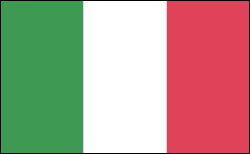ITALY

Geography: Italy, slightly larger than Arizona, is a long peninsula shaped like a boot, surrounded on the west by the Tyrrhenian Sea and on the east by the Adriatic. It is bounded by France, Switzerland, Austria, and Slovenia to the north. The Apennine Mountains form the peninsula's backbone; the Alps form its northern boundary. The largest of its many northern lakes is Garda (143 sq mi; 370 sq km); the Po, its principal river, flows from the Alps on Italy's western border and crosses the Lombard plain to the Adriatic Sea. Several islands form part of Italy; the largest are Sicily (9,926 sq mi; 25,708 sq km) and Sardinia (9,301 sq mi; 24,090 sq km).
Government: Republic.
History: The migrations of Indo-European peoples into Italy probably began about 2000 B.C. and continued until 1000 B.C. From about the 9th century B.C. until it was overthrown by the Romans in the 3rd century B.C. , the Etruscan civilization was dominant. By 264 B.C. , all Italy south of Cisalpine Gaul was under the leadership of Rome. For the next seven centuries, until the barbarian invasions destroyed the western Roman Empire in the 4th and 5th centuries A.D. , the history of Italy is largely the history of Rome. From 800 on, the Holy Roman Emperors, Roman Catholic popes, Normans, and Saracens all vied for control over various segments of the Italian peninsula. Numerous city-states, such as Venice and Genoa, whose political and commercial rivalries were intense, and many small principalities flourished in the late Middle Ages. Although Italy remained politically fragmented for centuries, it became the cultural center of the Western world from the 13th to the 16th century.
Government: Republic.
History: The migrations of Indo-European peoples into Italy probably began about 2000 B.C. and continued until 1000 B.C. From about the 9th century B.C. until it was overthrown by the Romans in the 3rd century B.C. , the Etruscan civilization was dominant. By 264 B.C. , all Italy south of Cisalpine Gaul was under the leadership of Rome. For the next seven centuries, until the barbarian invasions destroyed the western Roman Empire in the 4th and 5th centuries A.D. , the history of Italy is largely the history of Rome. From 800 on, the Holy Roman Emperors, Roman Catholic popes, Normans, and Saracens all vied for control over various segments of the Italian peninsula. Numerous city-states, such as Venice and Genoa, whose political and commercial rivalries were intense, and many small principalities flourished in the late Middle Ages. Although Italy remained politically fragmented for centuries, it became the cultural center of the Western world from the 13th to the 16th century.

Map of Italy
President: Sergio Mattarella (2015)
Prime Minister: Matteo Renzi
(2014)
Land area: 113,521 sq mi (294,019 sq km);
total area: 116,305 sq mi (301,230 sq km)
Population (2014 est.): 61,680,122 (growth
rate: 0.3%); birth rate: 8.84/1000; infant mortality rate: 3.31/1000;
life expectancy: 82.03
Capital and largest city (2011 est.):
Rome, 3.298 million
Other large cities: Milan 2.909 million; Naples 2.373 million; Turin 1.613 million; Palermo 915,000; Bergamo 784,000 (2011)
Monetary unit: Euro (formerly lira)
National
name: Repubblica Italiana
Languages:
Italian (official), German (parts of Trentino-Alto Adige
region are predominantly German-speaking), French (small French-speaking
minority in Valle d'Aosta region), Slovene (Slovene-speaking minority
in the Trieste-Gorizia area)
Ethnicity/race:
Italian (includes small clusters of German-,
French-, and Slovene-Italians in the north and Albanian- and
Greek-Italians in the south)
Religions:
Christian 80% (overwhelming Roman Catholic with very
small groups of Jehova Witnesses and Protestants), Muslims NEGL (about
700,000 but growing), Atheists and Agnostics 20%
National Holiday:
Republic Day, June 2
Literacy rate: 99% (2011 est.)
Economic summary: GDP/PPP (2013 est.):
$1.805 trillion; per capita $29,600. Real growth rate: -1.8%. Inflation: 1.2%. Unemployment: 12.4%. Arable land:
22.57%. Agriculture: fruits, vegetables, grapes, potatoes,
sugar beets, soybeans, grain, olives; beef, dairy products; fish.
Labor force: 25.74 million; services 67.8%, industry 28.3%,
agriculture 3.9% (2011). Industries: tourism, machinery, iron and
steel, chemicals, food processing, textiles, motor vehicles, clothing,
footwear, ceramics. Natural resources: coal, mercury, zinc,
potash, marble, barite, asbestos, pumice, fluorospar, feldspar, pyrite
(sulfur), natural gas and crude oil reserves, fish, arable land.
Exports: $474 billion (2013 est.): engineering
products, textiles and clothing, production machinery, motor vehicles,
transport equipment, chemicals; food, beverages and tobacco; minerals,
and nonferrous metals. Imports: $435.8 billion (2013
est.): engineering products, chemicals, transport equipment, energy
products, minerals and nonferrous metals, textiles and clothing; food,
beverages, and tobacco. Major trading partners: Germany,
France, U.S., Spain, UK, Switzerland, Netherlands, China, Russia, Belgium
(2011).
Communications: Telephones:
main lines in use: 21.656 million (2012); mobile cellular: 97.225
million (2012). Broadcast media: two Italian
media giants dominate - the publicly-owned Radiotelevisione Italiana
(RAI) with 3 national terrestrial stations and privately-owned Mediaset
with 3 national terrestrial stations; a large number of private stations
and Sky Italia - a satellite TV network; RAI operates 3 AM/FM
nationwide radio stations; some 1,300 commercial radio stations (2007). Internet hosts: 25.662
million (2010). Internet users: 29.235 million (2009).
Transportation: Railways: total: 20,255 km
(2008). Roadways: total: 487,700 km; paved: 487,700 km
(including 6,700 km of expressways) (2007).
Waterways: 2,400 km; note: used for commercial traffic; of
limited overall value compared to road and rail (2012). Ports and
terminals: Augusta, Cagliari, Genoa, Livorno, Taranto, Trieste, Venice
oil terminals: Melilli (Santa Panagia) oil terminal, Sarroch oil terminal. Airports: 129 (2013).
International disputes: Italy's long
coastline and developed economy entices tens of thousands of illegal
immigrants from southeastern Europe and northern Africa.
-------------------- o --------------------
No comments:
Post a Comment